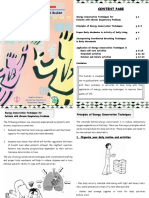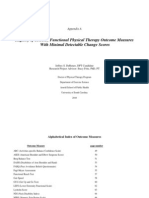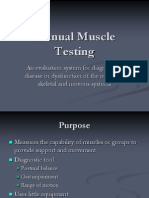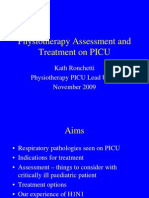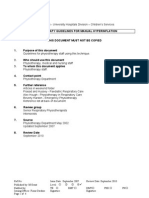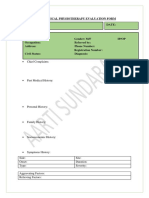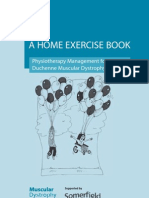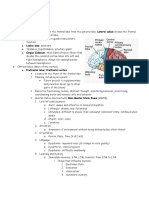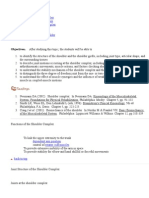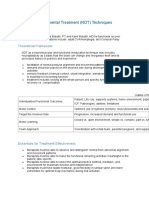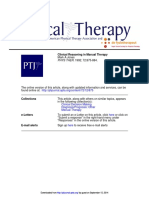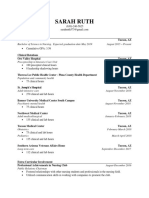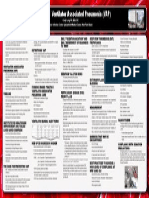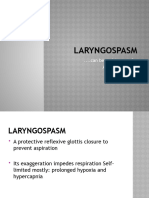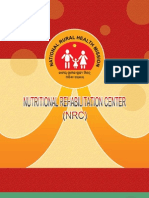PNF Table
PNF Table
Uploaded by
blitzkrieg5891Copyright:
Available Formats
PNF Table
PNF Table
Uploaded by
blitzkrieg5891Original Title
Copyright
Available Formats
Share this document
Did you find this document useful?
Is this content inappropriate?
Copyright:
Available Formats
PNF Table
PNF Table
Uploaded by
blitzkrieg5891Copyright:
Available Formats
Rhythmic initiation Rhythmic motion through desired range starting with passive motion progressing to active resisted motion
Combination of isotonics Combo of concentric, eccentric & stabilizing contractions of one group of muscles w/out relaxion Active control of motion Coordination Increase AROM Strengthen Func. Training in eccentric control Decr. Ecc. control Lack coordination Decr. AROM Lack of AROM
Dynamic reversals active motion changing from one direction (agonists) to opposite direction (antagonist) w/out pause or relaxation. Similar to throwing a ball, bicycling, walking increase AROM Strength develop coordination prevent or reduce fatigue increase endurance, decrease tone Decreased AROM weakness of agonists decr ability change directn exercised muscles fatigue relaxation hypertonic mm
Stabilizing reversals alternating isotonic contractions opposed by enough resistance to prevent motion push against by hangs or don t let me push you PT only allows small mvmt increase stability and balance increase muscle strength increase coordination between agonist and antagonist decreased stability weakness pt is unable to contract isometrically ands till needs resistance in a one way direction
Rhythmic stabilization alternating isometric contractions against resistance no motion intended
Goals
Indications
aid in initiation improve coord. & sense of motion normalize rate of motion(incr or decr) teach motion help pt relax difficulties initiating motion dysrhythmic motion (ataxia or rigidity) regulate or nomalize muscle tone general tension
Increase AROM and PROM Increase strength Increase stability and balance Decrease pain Limited ROM Pain, with motion Joint instability antagonistic weakness Decrease balance
Contra
Rhythmic stabilization may be too difficult with pt with cerebellar involvement If pt unable to follow instructions
Rhythmic initiation Description
Combination of isotonics passive motion using PT resists pt s speed of verbal moving actively command set rhythm through ROM (conc. pt asked to assist contraction) desired direction & At end, PT tells pt to return done by PT stay in position PT resists active (stabilizing mvemnt maintain contrctn) rhythm/verbal When stability pt finishes by making attained, PT tells pt motion allow part to be independently moved slowly back to the start position (ecc contraction) no relaxation btwn ecc or stabilizing muscle contraction may come before conc contraction
Dynamic reversals PT resists pt moving in 1 direction, usually stronger direction As end of desired range approaches PT reverses grip on distal portion of moving segment & gives command to prepare for change of direction At end of desired movement PT gives action command to reverse direction,w/out relaxation, gives resistance to new motion starting w/distal part When pt begins moving in opp direction, PT reverses proximal grip so all resistance opposes new direction done often as necessary start w stronger pattern finish w weaker
Stabilizing reversals PT gives resistance starting in strongest direction, very little motion allow Approx/traction should be used to incr stability When pt is fully resisting the force, PT moves one hand and begins to give resistance in another direction After pt responds to new resistance, PT moves other hand to resist new direction
Rhythmic stabilization PT resists isometric agonist contraction, pt maintains position w/out trying to move Resistance incr slowly as pt matches force When pt responding fully, PT moves 1 hand to begin resisting antagonistic motion at distal part- neither PT nor pt relaxes as resistance changes New resistance is built up slowly, as pt responds PT moves other hand to resist antagonistic motion Use traction/ approx as indicated Reversals repeated as often as needed command stay there don t try to move
Rhythmic initiation Modfication can be finished by combination of isotonics can be finished reversal of antagonists
Combination of isotonics May combine w/ reversal of antagonists Can start at end of ROM & begin w/ eccentric One type of muscle contraction can be changed to another before finishing ROM Change can be made from concentric to eccentric w/out stopping or stabilizing
Dynamic reversals Instead of moving thru full range, chng direction used emphasize particular ROM. Can begin w/ small motion in each direction incr ROM as strngth incr. Pt can be instructed to hold position & stabilize any point in range or at end can be done b4 or after reversing dirctn Can begin w/ stronger dirctn to gain irradiation weaker mm aftr reversng reversal should be done whnvr agonist fatigues If increasing strength is goal incr resistance w/each change Only use initial stretch reflex do not restretch when changng the direcn bc antagonist mm not under tension don t assist changing dirctns -Change direction emphasize particulr ROM
Stabilizing reversals Technique can begin w/slow reversals and progress to smaller ranges until pt is stabilizing Stabilization can start w/stronger muscles groups to facilitate weaker muscles Resistance may be moved around pt so that all muscle groups work Speed of reversal my be increased or decreased
remember
speed of verbal sets rhythm at the end patient should make motion independently technique may be combined
Start where pt has most strength/ best coord.Stabiliz or ecc contrctn may be 1st Emphasize end of range, start there w ecc contraction
Start working in the strongest direction Can begin with slow reversals and decrease range until pt is stabilizing
Rhythmic stabilization Can begin w/ stronger mm 4 facilitation weaker mm group (successive induction) Stabilizing activity can be followed by strengthening tech for weak mm To increase ROM, stabilization may be followed by asking pt to move farther into restricted range For relaxation, the pt may be asked to relax all muscles at the end for relaxation w/out pain technique may be done mm distant from painful area Use static commands bc no motion intended Stabilization may be done w mm distant from a painful area Stabilization can be followed by strengthnng technique
You might also like
- Cardio Pulmonary AssessmentDocument8 pagesCardio Pulmonary AssessmentSHAIK SHABEENANo ratings yet
- Energy Conservation TechniquesDocument9 pagesEnergy Conservation Techniquesqwas zNo ratings yet
- Registry of Outcome Measures With MDC 2010Document125 pagesRegistry of Outcome Measures With MDC 2010bdesai48100% (1)
- Cyriax IntroDocument14 pagesCyriax IntrodrrajmptnNo ratings yet
- Manual Muscle TestingDocument29 pagesManual Muscle TestingImran Ghafoor67% (6)
- @anesthesia Books 2013 Board StiffDocument302 pages@anesthesia Books 2013 Board StiffZulkarnainBustamamNo ratings yet
- Dermatology For The Small Animal Practitioner (Made Easy Series) PDFDocument163 pagesDermatology For The Small Animal Practitioner (Made Easy Series) PDFMaria Dumitru100% (1)
- 8 PNFDocument26 pages8 PNFsudersonNo ratings yet
- Traction: Cervical & LumbarDocument21 pagesTraction: Cervical & LumbarBoud ElhassanNo ratings yet
- 40 The Manual Diaphragm Release Technique Improves Diaphragmatic MobilityDocument8 pages40 The Manual Diaphragm Release Technique Improves Diaphragmatic MobilityRenan O. Pravatta PivettaNo ratings yet
- PNF For Lower LimbDocument22 pagesPNF For Lower LimbsanalcrazyNo ratings yet
- Physiotherapy For Stroke Patients - Physiotherapy Remedies For Victims of StrokeDocument9 pagesPhysiotherapy For Stroke Patients - Physiotherapy Remedies For Victims of StrokeHumaira RahmanNo ratings yet
- Faradic CurrentsDocument55 pagesFaradic CurrentsQiyao Leong100% (2)
- Dysphagia ManagementDocument21 pagesDysphagia ManagementSooraj A. O.100% (1)
- Physiotherapy Assessment and Treatment On PICUDocument54 pagesPhysiotherapy Assessment and Treatment On PICUBatool Rehman100% (3)
- Physiotherapy Guidelines For Manual HyperinflationDocument5 pagesPhysiotherapy Guidelines For Manual HyperinflationAhmed Abd Elrauf100% (2)
- Muhammed Kocabiyik Physical Medicine & Rehabilitation Iv. Class V. GroupDocument14 pagesMuhammed Kocabiyik Physical Medicine & Rehabilitation Iv. Class V. GroupsanalcrazyNo ratings yet
- Neurological Physiotherapy Evaluation FormDocument14 pagesNeurological Physiotherapy Evaluation FormHawi Natalie Tundang100% (2)
- Walking AidsDocument38 pagesWalking AidsMurad KurdiNo ratings yet
- Dr.P.Udhaya Kumar MD - PM&R 1st Year PG Department of PM&R Moderator Dr.S.Chidambaranathan Department of PaediatricsDocument45 pagesDr.P.Udhaya Kumar MD - PM&R 1st Year PG Department of PM&R Moderator Dr.S.Chidambaranathan Department of PaediatricsUdhaya KumarNo ratings yet
- Physiotherapy For PoliomyelitisDocument16 pagesPhysiotherapy For Poliomyelitisabdalsucs100% (1)
- Neuro AssessmentDocument6 pagesNeuro Assessmentfagpatel100% (1)
- Spinal Cord InjuryDocument39 pagesSpinal Cord Injuryrahat100% (1)
- Volkmann's Ischemic Contracture by Innocent C. AbuguDocument38 pagesVolkmann's Ischemic Contracture by Innocent C. AbuguChukwuemeka ChidogoNo ratings yet
- Complete Neurologic Interventions For Physical Therapy Third Edition Kessler PDF For All ChaptersDocument52 pagesComplete Neurologic Interventions For Physical Therapy Third Edition Kessler PDF For All Chapterstateiouazib100% (4)
- Physiotherapy Management of Cerebral Palsy Patient:-: Manual StretchingDocument5 pagesPhysiotherapy Management of Cerebral Palsy Patient:-: Manual StretchingMd Sherajul HaqueNo ratings yet
- Adverse Neural Tension 2012Document7 pagesAdverse Neural Tension 2012ramesh2007-mptNo ratings yet
- Free Exercise Guide For Physiotherapy StudentsDocument14 pagesFree Exercise Guide For Physiotherapy StudentssenthilkumarNo ratings yet
- Case Study On Lower Cross Syndrome.Document2 pagesCase Study On Lower Cross Syndrome.MRITUNJAY KUMAR SHARMANo ratings yet
- A Home Exercise BookDocument28 pagesA Home Exercise BookNameeta Shroff Jain100% (1)
- Total Knee Replacement Exercise ProtocolDocument2 pagesTotal Knee Replacement Exercise ProtocolMaricar Enriquez-ZingapanNo ratings yet
- Amputee Physiotherapy Assessment FormDocument8 pagesAmputee Physiotherapy Assessment FormHari25885100% (1)
- PT Neuro Intro NotesDocument13 pagesPT Neuro Intro NotesSusan K100% (2)
- Manual Muscle Testing: Grade Value DescriptionDocument40 pagesManual Muscle Testing: Grade Value Descriptionjoanna gurtizaNo ratings yet
- Shoulder PT AssessmentDocument5 pagesShoulder PT AssessmentNEELESH CHOUDHARYNo ratings yet
- History Taking Form Final - Doc Version 1Document5 pagesHistory Taking Form Final - Doc Version 1Mahnoor AqeelNo ratings yet
- Emg BiofeedbackDocument38 pagesEmg BiofeedbackSreeraj S RNo ratings yet
- Post operative physiotherapy management for flail chest or Multiple ribs fracture or Cardio-pulmonary rehabilitation or physiotherapy or physical therapy or flail chest or BPT or MPT or PT or project report or case study or medical field or MGR medical university or Senthil Kumar BPTDocument67 pagesPost operative physiotherapy management for flail chest or Multiple ribs fracture or Cardio-pulmonary rehabilitation or physiotherapy or physical therapy or flail chest or BPT or MPT or PT or project report or case study or medical field or MGR medical university or Senthil Kumar BPTdskmpt89% (9)
- Physiotherapy Care Protocol For Oa KneeDocument33 pagesPhysiotherapy Care Protocol For Oa KneealiaarifNo ratings yet
- Roods ApproachDocument33 pagesRoods ApproachCedricFernandez100% (1)
- Shoulder ComplexDocument14 pagesShoulder Complexbhavesh jain100% (5)
- F16 Physiotherapy After Stroke - 0Document15 pagesF16 Physiotherapy After Stroke - 0Mohammad Reyaz AhmadNo ratings yet
- Bobath ApprochDocument2 pagesBobath ApprochRùpám KanungoNo ratings yet
- 15 - Normal and Abnormal GaitDocument57 pages15 - Normal and Abnormal GaitYin-Ting Chen50% (2)
- Physiotherapy in IcuDocument18 pagesPhysiotherapy in Icu_darkangel26_50% (2)
- Brunnstrom ApproachDocument33 pagesBrunnstrom ApproachAISHWARYA SWAMINATHANNo ratings yet
- Acromioclavicular Joint Injuries and Physical Therapy ManagementDocument12 pagesAcromioclavicular Joint Injuries and Physical Therapy ManagementSereinNo ratings yet
- Role of PhysiotherapyDocument23 pagesRole of PhysiotherapyVikas ChaitanyaNo ratings yet
- GONIOMETRYDocument28 pagesGONIOMETRYnn2dgdypkcNo ratings yet
- Neuro Developmental Treatment (NDT) Techniques: HistoryDocument3 pagesNeuro Developmental Treatment (NDT) Techniques: HistoryGafencu SergiuNo ratings yet
- ApproachDocument37 pagesApproachAshu AshNo ratings yet
- McKenzie CONCEPT AnilDocument12 pagesMcKenzie CONCEPT AnilSOUMYADEEP BHUINYANo ratings yet
- Knee OsteoarthritisDocument7 pagesKnee OsteoarthritisSteve ColbertNo ratings yet
- Brunnstrom ApproachDocument32 pagesBrunnstrom ApproachTalha ParkarNo ratings yet
- S E - A /A: Houlder Xercises Ctive SsistedDocument3 pagesS E - A /A: Houlder Xercises Ctive SsistedmitchNo ratings yet
- Dr. Maheshwari Harishchandre Assistant Professor M.P.TH (Neurosciences)Document46 pagesDr. Maheshwari Harishchandre Assistant Professor M.P.TH (Neurosciences)Nikks Borade100% (1)
- What Is PNF Stretching and How Should You Use ItDocument12 pagesWhat Is PNF Stretching and How Should You Use Itsardianti dwitirtaNo ratings yet
- Recent Advances in PhysiotherapyFrom EverandRecent Advances in PhysiotherapyCecily PartridgeNo ratings yet
- Mobilization and Stimulation of Neuromuscular Tissue (MaSoNT)From EverandMobilization and Stimulation of Neuromuscular Tissue (MaSoNT)No ratings yet
- DeQuervain Disease, A Simple Guide To The Condition, Treatment And Related ConditionsFrom EverandDeQuervain Disease, A Simple Guide To The Condition, Treatment And Related ConditionsNo ratings yet
- Antibiotics in SurgeryDocument18 pagesAntibiotics in SurgeryGiovanni HenryNo ratings yet
- Clinical Reasoning - Jones PDFDocument12 pagesClinical Reasoning - Jones PDFIsabelGuijarroMartinezNo ratings yet
- Laporan Obat Dan BMHPDocument120 pagesLaporan Obat Dan BMHPHendra Dika SetiawanNo ratings yet
- Guideline For Drinking Water Quality PDFDocument202 pagesGuideline For Drinking Water Quality PDFStepKit100% (2)
- Week 11 Case Study - Dog With PruritusDocument9 pagesWeek 11 Case Study - Dog With Pruritusapi-301746262No ratings yet
- Hip Flexors - The Iliopsoas - Tightness or WeaknessDocument4 pagesHip Flexors - The Iliopsoas - Tightness or Weaknessatpicker100% (1)
- Sarah Ruth: Education and TrainingDocument2 pagesSarah Ruth: Education and Trainingapi-457033142No ratings yet
- Drug Profile: C H FN ODocument2 pagesDrug Profile: C H FN Ohamed razaNo ratings yet
- Licensed Practical Nurse DutiesDocument5 pagesLicensed Practical Nurse DutiesGurvinder SandhhuNo ratings yet
- Vap Poster WPB VaDocument1 pageVap Poster WPB VaJoe ThesecondmonthNo ratings yet
- Alkes Rsud PHWT To K Endy 2016Document184 pagesAlkes Rsud PHWT To K Endy 2016Nurhayati K Yusuf PilomuliNo ratings yet
- Materi Dr. Ibrahim Agung, SPKFRDocument30 pagesMateri Dr. Ibrahim Agung, SPKFRGhea Putri HendrianiNo ratings yet
- METRONDocument51 pagesMETRONMarcerce100% (1)
- LARYNGOSPASAMDocument21 pagesLARYNGOSPASAMMuhammad Bilal DallanwalNo ratings yet
- Exiben by Kamruzzaman 2018Document13 pagesExiben by Kamruzzaman 2018md. kamruzzamanNo ratings yet
- Nutritional Rehabilitation CenterDocument12 pagesNutritional Rehabilitation CenterKunal Yadav0% (1)
- Vedic Medicinal PlantsDocument57 pagesVedic Medicinal PlantsLalit MishraNo ratings yet
- Cold Agglutinin DiseaseDocument8 pagesCold Agglutinin Diseasehtunnm@gmail.comNo ratings yet
- Package Insert Hiv-1 VLDocument26 pagesPackage Insert Hiv-1 VLSagir AlvaNo ratings yet
- EMERGING INFECTION DISEASE CDCvol 24 No 8 2018 PDFDocument216 pagesEMERGING INFECTION DISEASE CDCvol 24 No 8 2018 PDFanyNo ratings yet
- Operative Hip ArthrosDocument286 pagesOperative Hip Arthrosанна косичкинаNo ratings yet
- Role of Community Pharmacist: BY: Md. Mynul Hasan Southeast UniversityDocument10 pagesRole of Community Pharmacist: BY: Md. Mynul Hasan Southeast UniversityFerdous MostofaNo ratings yet
- Chest DrainageDocument22 pagesChest DrainageAmeliaM100% (7)
- Dental Plaque and CalculusDocument32 pagesDental Plaque and Calculus蔡長家No ratings yet
- Leukoplakia and HomoeopathyDocument8 pagesLeukoplakia and HomoeopathyDr. Rajneesh Kumar Sharma MD Hom100% (1)
- Radilogic TechnologyDocument3 pagesRadilogic TechnologyAnnalou Love B. UmacobNo ratings yet
- Atonia UteriDocument22 pagesAtonia UteriDarra KurniasariNo ratings yet
- NeulinDocument3 pagesNeulinRinGo PleNo ratings yet

